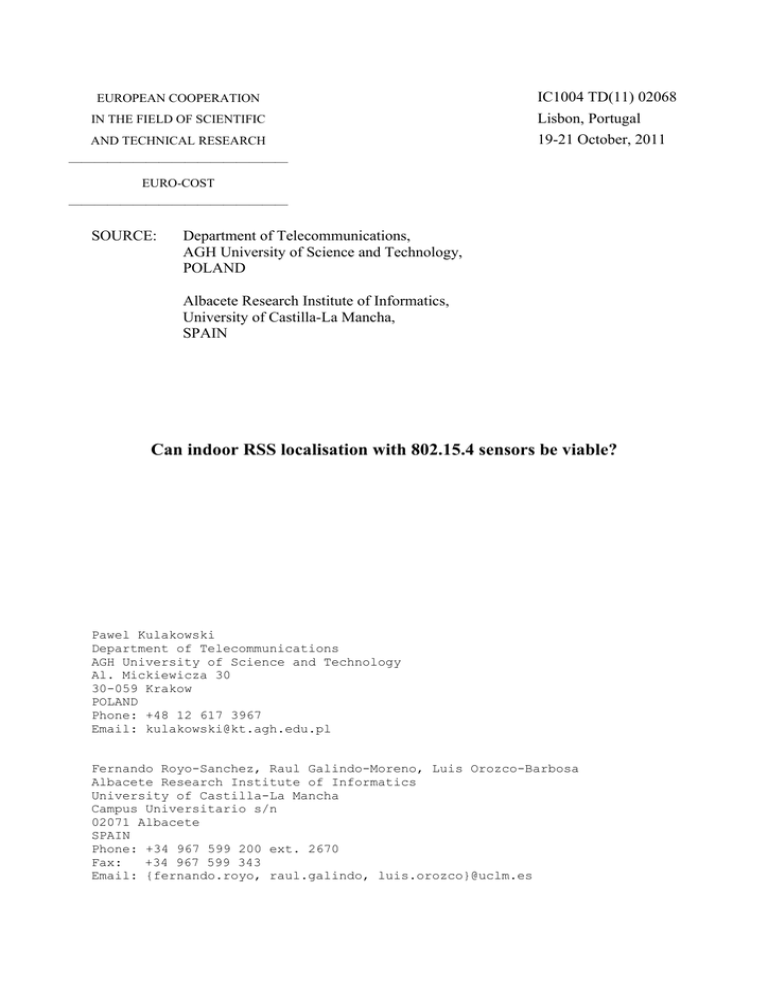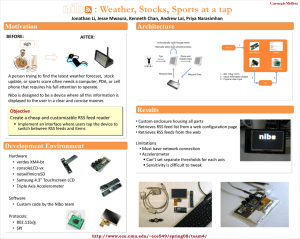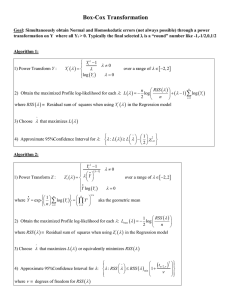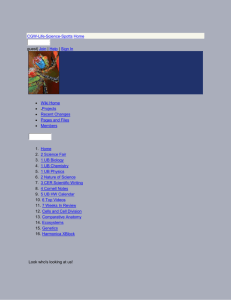Indoor RSS Localisation with 802
advertisement

EUROPEAN COOPERATION
IN THE FIELD OF SCIENTIFIC
AND TECHNICAL RESEARCH
IC1004 TD(11) 02068
Lisbon, Portugal
19-21 October, 2011
—————————————————
EURO-COST
—————————————————
SOURCE:
Department of Telecommunications,
AGH University of Science and Technology,
POLAND
Albacete Research Institute of Informatics,
University of Castilla-La Mancha,
SPAIN
Can indoor RSS localisation with 802.15.4 sensors be viable?
Pawel Kulakowski
Department of Telecommunications
AGH University of Science and Technology
Al. Mickiewicza 30
30-059 Krakow
POLAND
Phone: +48 12 617 3967
Email: kulakowski@kt.agh.edu.pl
Fernando Royo-Sanchez, Raul Galindo-Moreno, Luis Orozco-Barbosa
Albacete Research Institute of Informatics
University of Castilla-La Mancha
Campus Universitario s/n
02071 Albacete
SPAIN
Phone: +34 967 599 200 ext. 2670
Fax:
+34 967 599 343
Email: {fernando.royo, raul.galindo, luis.orozco}@uclm.es
CAN INDOOR RSS LOCALISATION WITH 802.15.4 SENSORS BE VIABLE?
Pawel Kulakowski, Fernando Royo-Sanchez, Raul Galindo-Moreno, Luis Orozco-Barbosa
Abstract
Indoor localisation techniques based on receive signal strength (RSS) level are
commonly considered to be unreliable and inaccurate mainly because of the phenomena of
multipath propagation, wireless fadings and common non-line-of-sight conditions. On the
other hand, all other localisation algorithms require that the wireless devices are modified
with some extra hardware, e.g. directional antennas, ultra-wideband or acoustic modules.
In this document, we present the measurements of localisation accuracy using an IEEE
802.15.4 sensor network consisting of 43 TelosB motes deployed in a university building.
While we are currently during a measurement campaign, we would like to share and discuss
our initial results. Our network suffers from well-known limitations typical for RSS
techniques, however we identify and validate some additional methods that can increase the
position estimation accuracy.
1. Introduction
While in outdoor scenarios GPS-like systems seem to be a widely accepted standard,
in indoor environments the problem of localisation of a wireless device remains an open and
hot topic. The phenomena of multipath radio propagation, wireless fadings and frequent
NLoS conditions pose numerous difficulties in creating a reliable and accurate localisation
system.
In this paper, we investigate if and how wireless sensor networks compliant with IEEE
802.15.4 standard can perform localisation tasks. Wireless sensors can be easily deployed
indoor in a large number of nodes and thus are well suited to serve for the localization
purpose. They are however equipped with rather simple radio transceivers and have limited
processing capabilities. Here, we present initial results from a receive signal strength (RSS)
measurement campaign performed with a 43-node TelosB sensor network. We propose to
exploit frequency diversity in order to minimize the adverse multipath propagation effects.
We analyse two localisation algorithms and compare their efficiency on the basis of the
performed measurements.
2. Problem definition
The research task considered in this paper is known as a RSS-channel-model-based
localisation problem without any a priori RSS maps [1] and can be described as follows.
There is a sensor node located in a building and its position (geographical coordinates) is
unknown. The sensor is transmitting a radio signal with a predefined strength. There is also a
sensor network consisting of a large number of nodes. Their positions are fixed and known.
They receive the transmitted signal and register its RSS level. In our measurements, the
transmitting node as well as all the nodes of the network are TelosB motes. For the purpose of
this paper, we call the unlocalized node as sensor and the nodes with known positions as
anchors. The main goal of the localisation algorithms investigated here is to calculate the
sensor position on the basis of the RSS levels measured by anchors.
At the same time we assume that there is no RSS map of the building, nor analytical
neither empirical, available a priori. RSS maps require very detailed propagation
measurements or analytical radio modelling taking into account the positions of all the walls,
doors, windows and other objects reflecting or blocking radio waves. Our motivation is to
discuss a system that can work without such maps. It means that the exact relation between
the radio signal attenuation and the sensor-anchor distance remains unknown.
In the reported measurements, the height of the transmitting node was always the same
(0.73 m above the floor level) and we assume it is known for the sensor network. Thus, our
localisation problem is reduced to the 2D-space. In general, our research problem can be
easily extended to 3 dimensions. However, as all the receivers are deployed more or less at
the same height (2.75 m), we expect that the localisation error of the third dimension might be
larger than the errors reported in this paper.
3. Transmission and reception schemes
One of our main motivations for these measurements was to look how we could
mitigate the adverse phenomenon of wireless fadings. Thus, we decided to conduct the
transmission on two radio channels and take advantage of frequency diversity. To avoid the
same wireless fades, the channels should be separated more than the coherence bandwidth
characterising this propagation environment [2]. The coherence bandwidth can be calculated
as:
1
,
(1)
Bcoh =
2 ⋅ Td
where Td is the respective time delay spread [3]. Typical values of Td for indoor radio
channels are equal to 10 ns or higher [2,4]. Thus, for the worst case of 10 ns, the channels
should be separated by 50 MHz or more in order to exploit their frequency diversity.
The TelosB motes can communicate on 16 radio channels numbered from 11 to 26.
Their carrier frequencies are separated by 5 MHz according to the following equation:
f k = 2405 + 5 ⋅ (k − 11) MHz , k = 11,...,26 ,
(2)
where k is the number of the radio channel. At the channel from 18 to 23, we observed some
interference signals from other wireless systems working in our building. Hence, for our
experiment we finally chose the border channels 11 and 26 separated by 75 MHz and easily
fulfilling the abovementioned frequency diversity condition.
In order to avoid the problem of sensor-anchors synchronisation, the transmitting
sensor was programmed to send data during 20 ms using the channel 11, then to switch to the
channel 26 and also use it during 20 ms. Then, the transmitter was returning to the channel 11,
continuing the switching process. On the other hand, the anchors were listening to the channel
11 during 40 ms, then switching to the channel 26 for another 40 ms, and so on. Thus, we
guaranteed that for each 40 ms of listening to a channel (11 or 26), exactly 50% of this time
period was effectively realised during the transmission on the same frequency, without any
extra synchronisation. This, however, came with a price of losing another 50% of time for idle
listening.
4. Localisation algorithms
Using TelosB hardware, we are able to measure the RSS level. As a second step, we
need an algorithm in order to transform the sets of RSS values into the transmitter
coordinates. We considered two solutions: the lateration and weighted mean algorithms.
The lateration algorithm is one of the most common methods of calculating the sensor
position when the distances from the sensor to a group of anchors are known [5]. Having k
anchors, we can write down a system of k equations:
( X − x1 ) 2 + (Y − y1 ) 2 + ( Z − z1 ) 2 = d1 2
M
(3)
2
2
2
2
( X − x k ) + (Y − y k ) + ( Z − z k ) = d k
where ( xi , y i , z i ) are the i-th anchor coordinates and ( X , Y , Z ) are sensor coordinates. In all
our measurements Z = 0.73 m and we assume that this value is known. Determining the
( X , Y ) pair is the main goal of the algorithm.
However, in our scenario the distances d i are also unknown. We have measured only
the RSS levels for each sensor-anchor path. Each RSS level can be transformed into a
distance value only if a path loss propagation model is known. When we have no information
about the propagation environment (the positions of walls and other obstacles blocking or
reflecting radio waves) the following relationship is frequently assumed:
(4)
PL [dB] = A + B ⋅ log10 f + 10 ⋅ n ⋅ log10 d ,
where PL is the average radio channel path loss, f is the carrier frequency and d is the
distance between the transmitter and the receiver. The parameters A, B and n depend on the
model, but B is usually between 20 and 25 and n (so called channel exponential coefficient) is
widely accepted to be between 2 and 6. For some models, there is also one or more threshold
distances defined. Parameters A, B and n can change depending if the distance is below or
above a certain threshold. A large group of propagation models falling into this category
includes the free space loss, 2-path model and numerous models based on measurements
[2,6].
In our system we use two radio channels with carrier frequency of 2405 and 2480
MHz. Even in the worst case (B = 25), the path loss for these two channels does not differ
widely: it is about 0.33 dB. The TelosB hardware registers the RSS level with 1 dB
resolution, so we neglected the influence of the frequency on the channel attenuation and used
a simplified channel path loss model:
PL [dB] = A ' + 10 ⋅ n ⋅ log10 d .
(5)
When the path loss is measured (measuring the RSS level and knowing the sensor
transmission power), the sensor-anchor distance can be calculated as:
PL − A'
= 10 10⋅n
d
Substituting d in (3) with (6), we obtain:
.
( X − x1 ) 2 + (Y − y1 ) 2 + ( Z − z1
M
(6)
PL1 − A'
) 2 = 10 5⋅n
PLk − A'
2
) = 10 5⋅n
(7)
( X − x k ) 2 + (Y − y k ) 2 + ( Z − z k
Let us assume for a moment that the channel coefficient n is known. Also, let us substitute
L
− A'
= 10 5⋅n
:
( X − x1 ) + (Y − y1 ) + ( Z − z1 )
2
2
M
2
PL1
= 10 5⋅n
⋅L
(8)
PLk
2
) = 10 5⋅n
( X − x k ) 2 + (Y − y k ) 2 + ( Z − z k
⋅L
Then, we can think of (8) as a system of equations with 3 unknown independent quantities: X,
Y and L. It can be linearized by subtracting first equation from k-1 others:
2( x1 − x 2 ) ⋅ X + x 2 − x1 + 2( y1 − y 2 ) ⋅ Y + y 2 − y1 + 2( z1 − z 2 ) ⋅ Z + z 2 − z1 =
2
2
2
2
2
2
M
2( x1 − x k ) ⋅ X + x k − x1 + 2( y1 − y k ) ⋅ Y + y k − y1 + 2( z1 − z k ) ⋅ Z + z k − z1 =
2
2
2
2
2
2
PL2
(10 5⋅n
PL1
− 10 5⋅n
)⋅L
PLk
(10 5⋅n
PL1
− 10 5⋅n
)⋅L
(9)
As the first equation, we always choose the one related to the anchor registering the highest
RSS level. The rationale behind this decision is that this anchor is probably located very close
to the sensor and its RSS level is statistically more reliable than others.
The system of k-1 linear equations with 3 unknowns can be easily solved with the
standard least-square approach [5], if only k-1 ≥ 3. Thus, in order to calculate the sensor
position, there should be at least 4 anchors that correctly registered RSS values. It should be
noted that the value of L (as well as A') is not important for the final result.
Additionally, we propose to multiply the equations in (9) (both left and right sides of
equations) by weighting coefficients wi. A weighting coefficient for the i-th equation (related
to the i-th anchor) is equal to:
wi = RSS i ⋅ si ,
(10)
where RSS i is the RSS level received by i-th anchor and si is the number of its correctly
measured probes. The weighting coefficients increase the importance of anchors registering
more probes and higher RSS levels what results in better localisation accuracy.
Still, as the radio propagation model is not given a priori, the channel coefficient n
cannot be treated as a known parameter. Concluding from the indoor measurements for NLoS
scenarios [6] and theoretical derivations of 2-path model, we expect that n is close to 4 also in
our case. In section 6, we present measurement results showing that the localisation accuracy
weakly depends on n, as long as n ∈< 2.5, 4 > .
The second considered solution how to calculate the sensor coordinates was the
weighted mean algorithm. This is very simple technique: the sensor positions is estimated as a
weighted mean of anchors coordinates. As weighting coefficients we use the values from (10).
5. Measurement scenario
All the measurements were performed on the second floor of Albacete Research
Institute of Informatics. The TelosB network (anchors) had been installed in the building
before our tests for the purpose of measuring the ambient parameters (temperature, energy
usage, etc.) and testing other WSN protocols and algorithms [7]. Nothing has been changed in
its configuration from that time. The network consisted of 43 TelosB motes [8] deployed in
the labs on the floor of area of 46 × 15 m2 (Fig. 1). They were programmed to listen to the
radio signal and measure its RSS level. The receivers were switching between channels 11
and 26, as described in the section above.
Fig. 1. The plan of the floor with the TelosB sensor network deployed.
Except of the deployed network, we used a single TelosB sensor, whose position we
wanted to calculate with the aid of the localisation system. This sensor was continuously
transmitting data: packets with a fixed length of 127 bytes, which is the largest possible
packet size according to the IEEE 802.15.4 standard. The packets were transmitted switching
between the channels 11 and 26, once per 20 miliseconds. The transmitted power was set to 1
mW (0 dBm).
The transmitting sensor was placed in turn at 103 different locations. For each sensor
location, the anchors measured RSS levels during 1 second: the probes were gathered once
per 2 ms, thus 500 probes were obtained each time. However, because of the lack of sensoranchors synchronisation (see section above) and time intervals appearing between the
transmitted packets, the number of correct probes were much smaller. The probes with RSS
level lower than –85 dBm were rejected as being incorrect.
For each of 103 measurements, each anchor registered 8 different parameters: the
number of correctly measured probes, minimum, average and maximum RSS values for the
channel 11, as well as the same 4 parameters for the channel 26.
6. Results
The values registered by anchors could be used as input data for a localisation
algorithm. We could use minimum, average or maximum RSS for the channel 11 or 26. We
could also compare the respective channel 11 and 26 values and choose one of them. We
tested two simple criteria: choosing the higher or lower value of two channels. Thus, we had 4
different approaches: choosing the RSS value of the channel 11, 26, higher or lower of them.
For each approach we could use minimum, average or maximum RSS values. So finally, we
had 12 parameters that could be used with both lateration or weighted mean algorithms. We
calculated the root-mean-square-error of the estimated sensor position for both localisation
algorithms in each of these 12 cases and compared the respective results in Tab. 1 and 2.
minimum values
average values
maximum values
channel 11
9.42 m
7.60 m
9.59 m
channel 26
6.98 m
4.97 m
6.51 m
lower of both
8.87 m
6.17 m
7.01 m
higher of both
7.32 m
6.23 m
8.21 m
Table 1. The root-mean-square-error of the lateration localisation algorithm.
minimum values
average values
maximum values
channel 11
7.15 m
7.02 m
6.01 m
channel 26
4.12 m
4.29 m
4.41 m
lower of both
5.67 m
2.98 m
3.87 m
higher of both
5.83 m
7.42 m
5.95 m
Table 2. The root-mean-square-error of the weighted mean algorithm.
The results in Tab. 1 are given for the channel exponential coefficient n = 4. An analysis what
is the influence of n on the localisation accuracy is presented in Fig. 2. There, two best cases
from Tab. 1 (marked in blue) are considered. In the first one, the average RSS values of the
channel 26 are taken into account. In the second one, the algorithm takes the lower value of
the average RSS levels of two channels.
Fig. 2. The root-mean-square-error as a function of the channel exponential coefficient.
Additionally, we gathered all the RSS values registered by the network during the whole
measurement campaign and prepared two figures showing the path loss as a function of the
distance. In Fig. 3, the average path loss for the channel 11 (2405 MHz) and the channel 26
(2480 MHz) is shown.
Fig. 3. The path loss as a function of the sensor-anchor distance for the channel 11 (on the left)
and the channel 26 (on the right).
7. Results analysis and conclusions
Taking into account the building size, the localisation accuracy of the lateration
algorithm is not satisfactory. In order to be considered as a reliable technique, lateration
requires accurate sensor-anchor distances. However, as shown in Fig. Xxx, there is no clear
dependence between RSS values and distance and consequently it is very hard to thoroughly
estimate a distance on the basis of a RSS value. The analysed lateration algorithm is rather
robust for erroneously chosen coefficient n, but in general its localisation error is quite large.
On the other hand, the weighted mean technique results in better accuracy of about 3
meters, which is comparable with other indoor localisation schemes reported in literature,
even with the techniques with a priori RSS maps [1]. Using the frequency diversity seems to
be a promising solution for the indoor localisation, as it allowed to reduce the root-meansquare-error by about 30 %. Surprisingly, the accuracy in the channel 11 was always worse
than in the channel 26. This issue requires some further investigations.
References
[1] A. Cenedese, G. Ortolan, M. Bertinato, Low Density Wireless Sensors Networks for
Localization and Tracking in Critical Environments, IEEE Transactions on Vehicular
Technology, vol. 59(6), pp. 2951-2962, 2010.
[2] T.S. Rappaport, Wireless Communications: Principles and Practice, Prentice Hall, 2001.
[3] D. Tse and P. Viswanath, Fundamentals of Wireless Communication, Cambridge
University Press, New York, 2005.
[4] http://wireless.per.nl/reference/contents.htm - Jean-Paul Linnartz website on wireless
communications, accessed 12 of October 2011.
[5] K. Langendoen and N. Reijers, Distributed localization in wireless sensor networks: a
quantitative comparison, Computer Networks (Elsevier), special issue on Wireless Sensor
Networks, November 2003.
[6] WINNER II Channel Models, http://www.ist-winner.org/deliverables.html, accessed 12 of
October 2011.
[7] P. Díaz, T. Olivares, R. Galindo, A. Ortiz, F. Royo, T. Clemente, The EcoSense Project:
An Intelligent Energy Management System with a Wireless Sensor and Actor Network,
Sustainability in Energy and Buildings, Smart Innovation, Systems and Technologies, vol. 7,
part 4, pp. 237-245, 2011.
[8] TelosB-datasheet: http://www.willow.co.uk/TelosB_Datasheet.pdf, accessed 12 of
October 2011.





